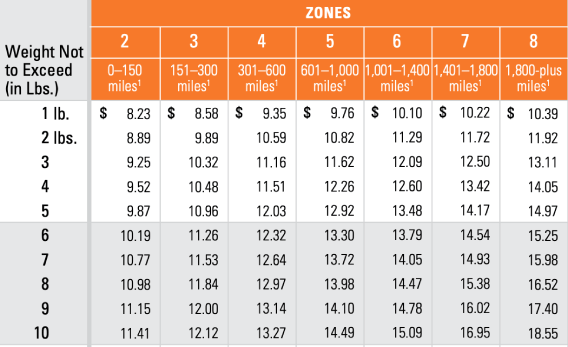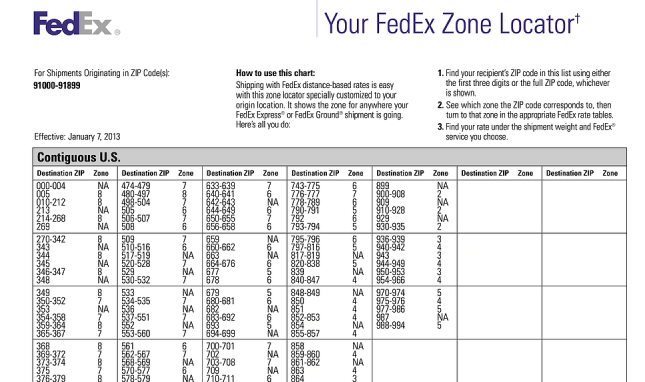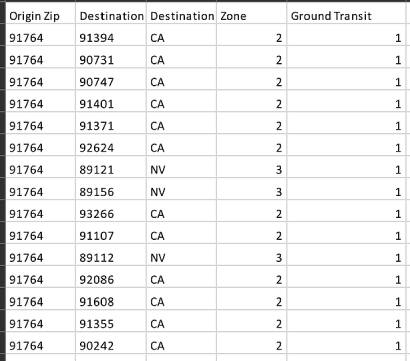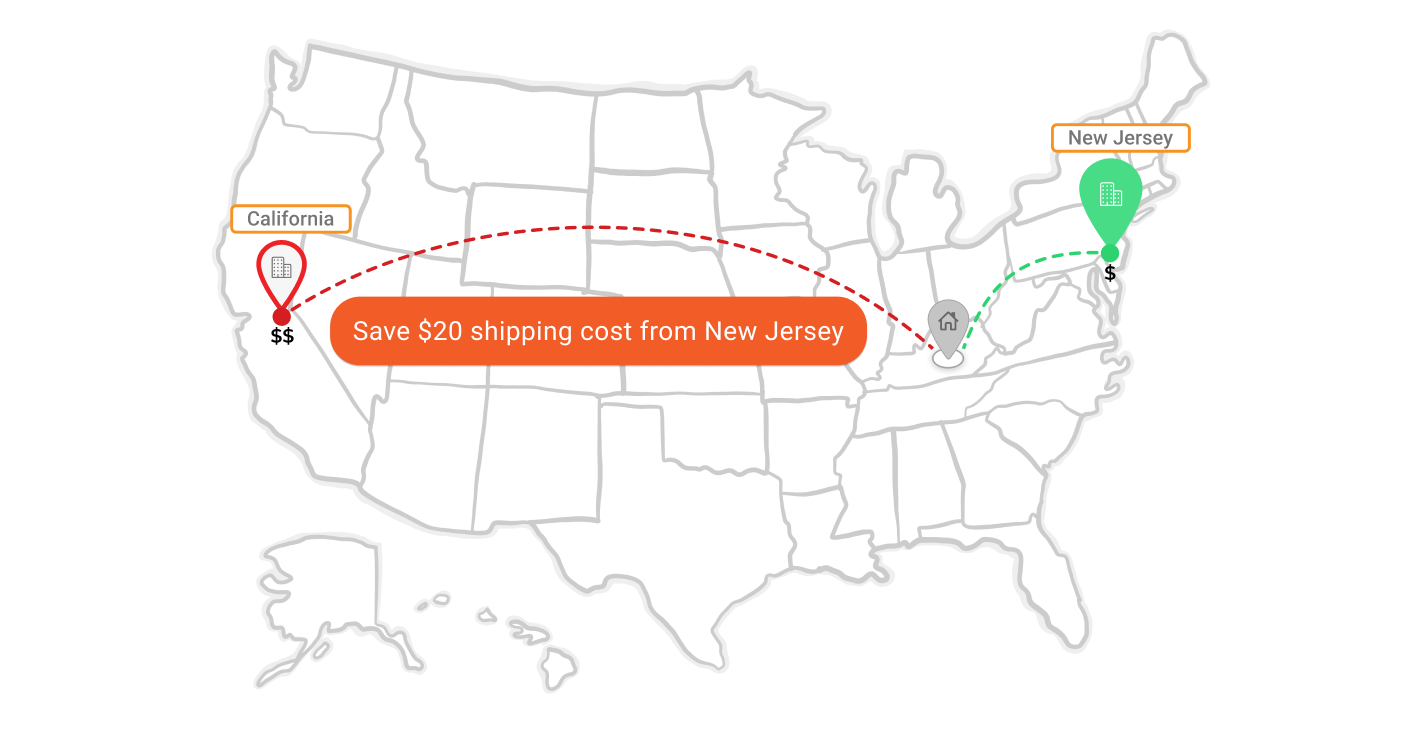At this point, we’ve all shopped at Amazon at least once, right? And if you’ve shopped once, you’ve probably come back a second or third time, likely because you were pleasantly surprised by the fast and free delivery options. Unfortunately, customers cannot currently expect the same delivery convenience and speed from specialty brand retailers like JCrew, Express, Vans, and the like, despite the fact that there is technology available to accomplish this experience.
There is no doubt that specialty brand retailers can promise affordable, or free, same-day delivery, just like Amazon, with the help of smart order routing and leveraging their network of retail stores as micro fulfillment centers.
So, in this blog, we will dive into smart order routing and how it can help retailers offer same-day delivery options to meet rising customer expectations.
What's The Status Quo?
Retailers that fulfill online orders only from dedicated fulfillment locations, as opposed to leveraging both warehouses and store networks to create a shared pool of inventory, generally experience some drawbacks.
Firstly, if an item is out of stock at a fulfillment location but can be found in-store, there is no avenue through which to leverage store inventory to fulfill customer demand. Secondly, retailers that depend on online-only fulfillment centers generally cannot offer same-day, next-day, or two-day delivery due to logistical inefficiencies.
There are several ways to tackle these challenges, the first being increasing the number of fulfillment centers in order to shrink the delivery window as much as possible. However, even this significant investment will not result in the next-day or same-day delivery that Amazon consistently offers. Established specialty brand retailers benefit from an expansive network of brick-and-mortar stores across the nation and globe. Using these locations as fulfillment locations provides an attractive opportunity to avoid out-of-stock scenarios and reduce the cost of express delivery.
Successful store fulfillment can only be achieved through an intelligent order routing engine. While young brands with only a handful of stores may be able to manually coordinate inventory transactions between stores, this is simply impossible for brands with high order volumes.
What Is Smart Order Routing?
Smart order routing is an automated process of handling incoming orders per a set of predefined rules, designed to assign orders to fulfillment locations in the most optimal way. The process of smart order routing is made possible through an order routing engine, a key component of a Distributed Order Management System (DOM). A DOM helps retailers optimize shipping costs and inventory utilization while meeting customers’ delivery expectations by fulfilling orders from a shared pool of inventory and optimizing inventory utilization.
Benefits of Smart Order Routing
-
Avoid out of stock situations and save the sale
-
Reduce delivery times
-
Reduce shipping costs
-
Increase inventory turnover and sell-through rate
-
Offer affordable same-day and next-day delivery options
Smart Order Routing Rules
Order routing engines determine the best fulfillment location based on a predefined set of rules that takes into account a variety of factors, including speed and profitability. Best-in-class solutions provide a variety of flexible rule options, which allow you to pivot your omnichannel order routing strategy according to demand or context.
Fulfillment From Warehouse or Store?
Smart order routing rules determine the optimal location for order fulfillment. This is generally accomplished by routing orders based on the proximity of the store or warehouse to the customer’s shipping address, which helps to reduce both delivery time and cost. If the customer chooses next-day delivery when placing an online order, the engine will use the proximity rule to ensure that the shipping promise is delivered.
On the other hand, if the customer chooses standard delivery (usually a 3-5 day window), the routing engine will select any warehouse or store that has the highest amount of inventory in order to increase inventory turnover and sell-through rate. You can configure your routing engine to run every 2 hours in order to pick up the latest orders and prioritize them in order of their delivery timelines.
In other words, the engine will begin with the next-day orders and route them to the appropriate location, before moving on to the 2-day delivery orders and so on. These rules work regardless of whether your brand relies only on warehouses, a combination of warehouses and retail locations, or only retail locations.
Leveraging Shipping Zones To Minimize Costs
A “shipping zone” refers to the distance that a shipment travels from the point of origin to the destination, measured in a grouping of zip codes. If a retailer is fulfilling an order from a fulfillment center, the center is the point of origin and the customer’s shipping address is the final destination. Zone numbers denote how far away a customer’s shipping address is from the fulfillment center. US shipping zones range from Zone 1 to Zone 8, with 1 being the nearest and 8 being the furthest.
These zones are used by shipping companies to determine the appropriate pricing. The shipping cost depends on the distance it needs to travel, which directly correlates to the numbered zones. Apart from the shipping service, the weight and dimension of the package are also factored into the pricing.
Below is the FedEx Standard rate list, last updated on January 6th, 2020:

Zones are dependent upon the carrier used and the service type (ground versus next day air). When working with FedEx, for example, if the fulfillment center is in Ontario, California and the shipping address of the customer is in Los Angeles, California, the delivery falls within Zone 2. This can easily be determined by downloading the FedEx Zone chart and entering the appropriate zip code.

FedEx zone files for all fulfillment centers and store locations, including the origin zip code, destination zip code, zone number, and transit days, can be loaded into the Distributed Order Management System in order to minimize shipping costs and maximize efficiency. Below is the zone file for FedEx Ground for a fulfillment center in Ontario.

When routing an order, the routing engine references the customer’s shipping address zip code in order to scour all possible storage locations and determine which one falls in the lowest zone to ensure speedy delivery at a low cost. Distributed Order Management Systems also have a fulfillment manager application to pick, pack, and ship orders once they are routed to the appropriate warehouse or store. After the order is packed, the fulfillment manager application generates shipping labels and rate-shops (a process of getting quotes for all FedEx service types like Ground, Next Day Air, and so on in order to choose the cheapest option). At times, the rate for Next Day Air shipping can be lower than Ground shipping, so it’s important to rate shop to ensure maximum cost savings.
Turn-On and Turn-Off Stores
Some retailers may require the ability to turn stores on and off as fulfillment centers as part of their smart order routing strategy. For example, on a particular day, a retail location may not have sufficient staff on hand to fulfill orders, or there may be a local issue that has led to the store closing for a period of time. In these cases, and others, retailers can simply “turn off” their stores and the routing engine will not route orders their way.
Split Orders
Let’s say that a customer orders multiple items online and the routing engine finds that no single warehouse or retail location has all of the necessary items in stock. Can the customer still expect their order on time? Absolutely! Retailers can activate the “split order” option, which allows the routing engine to fulfill partial orders from different locations and still meet the customer’s expected delivery date. Retailers can choose to limit the number of splits for any given order using the “max order split count functionality” in cases where fulfilling the order is cost-prohibitive.
However, it is important to note that order splitting generally increases costs and is often discouraged as a component of a smart order routing strategy. While order routing engines minimize the costs associated with this practice, it cannot eliminate them altogether. As a result, retailers do still have the option to turn off the “split order” option, with the understanding that this will likely lead to a delay in delivery.
Safety Stock
In some cases, retailers want to hold a certain amount of inventory in their stores as “safety stock” in order to avoid inventory depletion. This can absolutely be achieved through the engine by simply setting safety stocks for each product and location. For example, if a store sets a safety stock of 5 for a given SKU, and an online order comes in when the inventory levels at that location have fallen below 5, the routing engine will know not to send the order to that location.
While keeping safety stocks can certainly be a good strategy in order to ensure stores can satisfy the demand of their walk-in customers, it’s important not to hold onto inventory unnecessarily when customers elsewhere are eager to buy.
In order to avoid this scenario, it’s best to invest in an endless aisle solution that allows store associates to fulfill orders for out-of-stock items by leveraging excess stock from other locations. This approach allows retailers to limit the amount of safety stock needed whilst ensuring all customers receive the items they want as quickly as possible.
* * *
If your brand wants to achieve the fast and affordable delivery model popularized by Amazon, it’s time to start using your retail locations as fulfillment centers. There’s absolutely no reason to leave excess inventory lying around in-store when it can be put to better use satisfying online requests quickly and cost-effectively. An intelligent order routing engine is the most important element of a Distributed Order Management system because it enables retailers to fulfill from multiple locations, including warehouses and brick-and-mortar stores, to offer next-day and same-day delivery options for their customers whilst saving on shipping costs.
If you are interested in providing a seamless shopping experience to your customers and offering affordable same-day and next-day delivery options, contact our experts to discover our best-in-class smart order routing solution.






